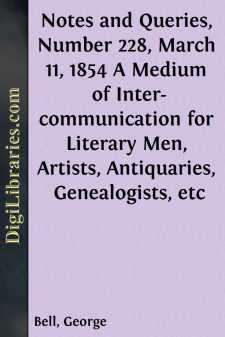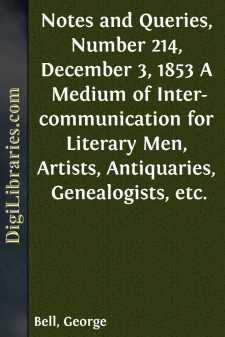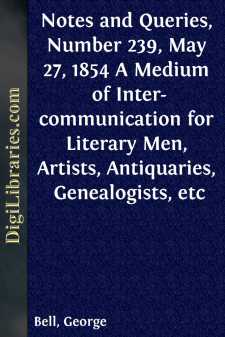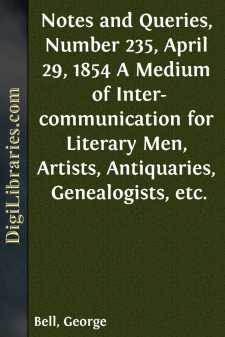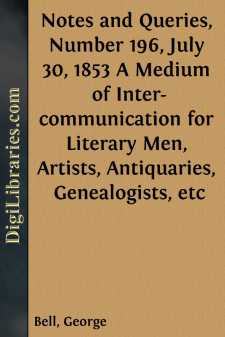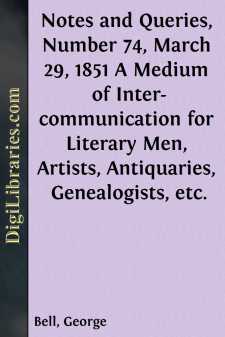Categories
- Antiques & Collectibles 13
- Architecture 36
- Art 48
- Bibles 22
- Biography & Autobiography 813
- Body, Mind & Spirit 142
- Business & Economics 28
- Children's Books 14
- Children's Fiction 11
- Computers 4
- Cooking 94
- Crafts & Hobbies 4
- Drama 346
- Education 46
- Family & Relationships 57
- Fiction 11828
- Games 19
- Gardening 17
- Health & Fitness 34
- History 1377
- House & Home 1
- Humor 147
- Juvenile Fiction 1873
- Juvenile Nonfiction 202
- Language Arts & Disciplines 88
- Law 16
- Literary Collections 686
- Literary Criticism 179
- Mathematics 13
- Medical 41
- Music 40
- Nature 179
- Non-Classifiable 1768
- Performing Arts 7
- Periodicals 1453
- Philosophy 64
- Photography 2
- Poetry 896
- Political Science 203
- Psychology 42
- Reference 154
- Religion 513
- Science 126
- Self-Help 84
- Social Science 81
- Sports & Recreation 34
- Study Aids 3
- Technology & Engineering 59
- Transportation 23
- Travel 463
- True Crime 29
Notes and Queries, Number 207, October 15, 1853 A Medium of Inter-communication for Literary Men, Artists, Antiquaries, Genealogists, etc.
by: George Bell
Categories:
Description:
Excerpt
Notes on Midland County Minstrelsy.
It has often occurred to me that the old country folk-songs are as worthy of a niche in your mausoleum as the more prosy lore to which you allot a separate division. Why does not some one write a Minstrelsy of the Midland Counties? There is ample material to work upon, and not yet spoiled by dry-as-dust-ism. It would be vain, perhaps, to emulate the achievements of the Scottish antiquary; but surely something might be done better than the county Garlands, which, with a few honorable exceptions, are sad abortions, mere channels for rhyme-struck editors. There is one peculiarity of the midland songs and ballads which I do not remember to have seen noticed, viz. their singular affinity to those of Scotland, as exhibited in the collections of Scott and Motherwell. I have repeatedly noticed this, even so far south as Gloucestershire. Of the old Staffordshire ballad which appeared in your columns some months ago, I remember to have heard two distinct versions in Warwickshire, all approaching more or less to the Scottish type:
"Hame came our gude man at e'en."
Now whence this curious similarity in the vernacular ideology of districts so remote? Are all the versions from one original, distributed by the wandering minstrels, and in course of time adapted to new localities and dialects? and, if so, whence came the original, from England or Scotland? Here is a nut for Dr. Rimbault, or some of your other correspondents learned in popular poetry. Another instance also occurs to me. Most of your readers are doubtless familiar with the pretty little ballad of "Lady Anne" in the Border Minstrelsy, which relates so plaintively the murder of the two innocent babes, and the ghostly retribution to the guilty mother. Other versions are given by Kinloch in his Ancient Scottish Ballads, and by Buchan in the Songs of the North, the former laying the scene in London:
"There lived a ladye in London,
All alone and alonie,
She's gane wi' bairn to the clerk's son,
Down by the green-wood side sae bonny."
And the latter across the Atlantic:
"The minister's daughter of New York,
Hey with the rose and the Lindie, O,
Has fa'en in love wi' her father's clerk,
A' by the green burn sidie, O."
A Warwickshire version, on the contrary, places the scene on our own "native leas:"
"There was a lady lived on lea,
All alone, alone O,
Down the greenwood side went she,
Down the greenwood side, O.
"She set her foot all on a thorn,
Down the greenwood side, O,
There she had two babies born,
All alone, alone O.
"O she had nothing to lap them in,
All alone, alone O,
But a white appurn and that was thin,
Down the greenwood side, O," &c.
Here there are no less than four versions of the same ballad, each differing materially from the other, but all bearing unmistakeable marks of a common origin. It would be interesting to know the process by which this was managed.
C. Clifton Barry.
Footnote 1:In one of the Scottish ballads the same idea is more prettily expressed "leaned until a brier."



